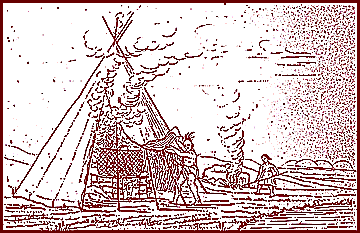 George Catlin's drawing of the
Mandan's sweat lodge in 1845. (From Sweat, copyright Mikkel Aaland:
http://www.cyberbohemia.com/Pages/historysweatlod.htm)
George Catlin's drawing of the
Mandan's sweat lodge in 1845. (From Sweat, copyright Mikkel Aaland:
http://www.cyberbohemia.com/Pages/historysweatlod.htm) George Catlin's drawing of the
Mandan's sweat lodge in 1845. (From Sweat, copyright Mikkel Aaland:
http://www.cyberbohemia.com/Pages/historysweatlod.htm)
George Catlin's drawing of the
Mandan's sweat lodge in 1845. (From Sweat, copyright Mikkel Aaland:
http://www.cyberbohemia.com/Pages/historysweatlod.htm)
Sweat Lodge
George Catlin wrote a lengthy description of the Mandan's sweat lodge in 1845, ending with the comment: "Such is the sudatory or vapour bath of the Mandans, and, as I before observed, it is resorted to both as an everyday luxury by those who have the time and energy to indulge in it; and also used by the sick as a remedy for nearly all the diseases which are known amongst them. Fevers are very rare, and in fact almost unknown amongst these people: but in the few cases of fever which have been known, this treatment has been applied, and without the fatal consequences which we would naturally predict."
Sweat lodges are part of nearly every native North American culture and have
always played an important role in rituals of healing, preparation, and prayer.
"Sweats" were repressed first by the Spaniards and later by the U.S. government,
hypocritically, since saunas and other therapeutic steam baths were popular
across Europe for centuries. The current fad for sweat lodges among non-Indians,
particularly in the men's movement, should not diminish our respect for this
ancient tradition.
Sweat Lodge Etiquette
The lodge represents Mother Earth and when we crawl out at the end of the
ceremony it is like a rebirth. We leave all our problems in there.
No women should come to the lodge when they are on their "Sacred Monthly Time." That is a ceremony in itself and according to the elders we cannot be in two ceremonies at the same time.
Please be open to learn and ask questions.
It is good to drink plenty of water the day of a lodge (especially in Utah where the elevation is high and it is very dry.)
Be sure not to over eat before a lodge. You may become nauseous
Do not attempt to leave the lodge while the door is closed.
(See: Joseph Bruchac, The Native American Sweat Lodge: History and Legends, 1993)